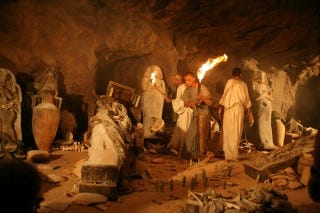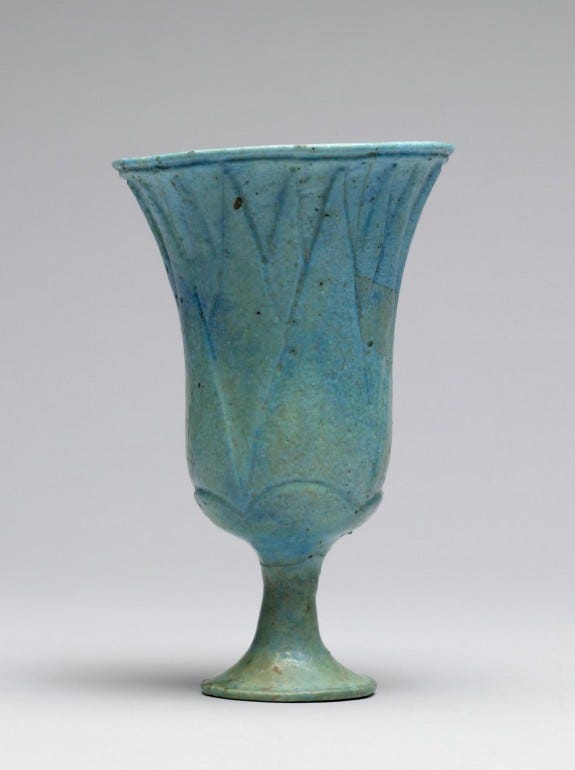Tomb Robbery: Then and Now
The Shadowy World of Ancient Egyptian Tomb Robbery: Secrets, Punishments, and the Lure of Hidden Treasures
When we think of ancient Egypt, grand tombs filled with gold, jewels, and priceless artefacts often come to mind. However, beneath the splendour, a darker side existed: tomb robbery. While Pharaohs and the elite sought eternal glory, their burial sites became prime targets for thieves driven by desperation, greed, or sheer opportunism, both in the past and today.
A Thriving Underground Economy
The 20th Dynasty, especially during the economic crisis, saw tomb robbery become a widespread issue. These robberies weren't limited to desperate individuals; they involved organized groups, sometimes even the families of the deceased. Inflation, unpaid workers, and a financial crisis fueled this underground economy in which burial goods were repurposed for everyday use.
Among the most sought-after items were gold, copper, jewellery, and amulets—all symbols of wealth, status, and protection for the afterlife. As burial practices evolved and tombs grew simpler, tomb robbers still found ways to extract value, contributing to a black market for sacred items.
Investigations and Insights: The Tomb Robbery Papyri
The "Tomb Robbery Papyri" provides information about how these thefts occurred, the culprits involved, and the brutal punishments they faced. One key piece of evidence is the Harris Papyrus, housed in the British Museum. It details the confession of Amenpnūfer, a quarryman caught in the act of robbing a tomb in Thebes. Following harsh interrogation, including beatings, Amenpnūfer gave intricate details of his crime and implicated others.
This era reveals how tomb theft wasn’t just a chaotic free-for-all but a calculated effort by robbers, some of whom were state employees. Even security measures, such as hiring guards or selecting more discreet burial sites, could not always prevent tomb desecration.
The Rise of Tomb Robbery in the Late Kingdoms
As Egypt faced increasing economic challenges, the frequency of tomb robberies surged. Amenhotep I built Deir el-Medina, a village to house tomb builders, initially to safeguard against looting. However, this community, reliant on the state for wages and food, eventually turned to tomb robbery when payments became delayed.
Workers took advantage of their inside knowledge, chiselling away at tombs they helped construct. This shows the level of desperation and exposes the flaws in the system meant to protect the resting places of the elite.
Shifting Burial Practices and Commodities
During the 21st Dynasty, burial practices began to simplify, yet the bodies gained value. Tomb robbers couldn’t just strip away gold and jewels; mummified remains became targets for thieves. Mummification became more intricate, with reconstructions of faces and the stuffing of abdomens to give the appearance of life. This shift made the body a valuable commodity, further intensifying the plundering of tombs.
Who Were the Culprits?
Tomb robbers came from various walks of life—stonemasons, coppersmiths, and even low-level officials. Poorly compensated guards were easily bribed, and those in charge of tomb construction often had intimate knowledge of burial sites, making them ideal candidates for tomb robbing.
This black market economy thrived on repurposing sacred items. Coffin metals like gold and copper could be melted down and sold without arousing suspicion, and jewellery was often disassembled and traded for its material worth.
The Pharaohs’ Dilemma
Shockingly, even pharaohs themselves were not immune to tomb robbery. In some cases, they sanctioned the re-use of burial goods from tombs, a practice that blurred the line between state-sanctioned re-appropriation and outright theft. This reveals the depth of Egypt's economic desperation during the late dynasties.
In one heartbreaking case, Khufu, the builder of the Great Pyramid, discovered his own mother’s tomb had been looted shortly after her burial. Unaware of the desecration, he had her coffin reburied without knowing her body had been taken.
The Punishments: Brutal Consequences
Tomb robbery was a crime that carried severe penalties, especially when it involved the tombs of pharaohs or high-ranking officials. Punishments ranged from beatings and forced labour to amputations and, in the worst cases, execution. These harsh sentences served as a deterrent, though the prevalence of tomb robbery suggests it wasn’t always effective.
The Nauri Decree of Seti I outlined strict punishments for those caught robbing tombs. It extended not only to the thieves themselves but often to their families, showing the severity with which tomb desecration was viewed in ancient Egypt.
Despite the ancient Egyptians' efforts to protect their dead, the lure of treasure and economic instability made tomb robbery a constant threat. The scale of tomb robbing suggests that the risk of being caught must have been low and worth the reward for many.
Modern Tomb Robbing in Egypt
Tomb robbing is not just a relic of ancient times—it remains a persistent and pressing issue in modern-day Egypt - everyone is at it. Indiana Jones, Assassin’s Creed, Lara Croft and films like The Mummy have blurred the lines that archaeology likes to draw between treasure-hunting and methodical excavations for many seeking their fortune. While those who seek merely a reputation, scholars fuelled by the thrill of stepping into spaces where time seems to have stood still also want to find new graves to open.
In modern Egypt, there are many dark interests and forces at play.
The Rise of Modern Tomb Robbery
The economic challenges in Egypt, along with political instability and the demand for antiquities on the global black market, have led to an increase in tomb robbing in recent decades. The 2011 revolution and subsequent unrest opened the floodgates for looters, who exploited the chaos to plunder historical sites. The temporary absence of law enforcement and a struggling economy drove many locals to partake in illegal excavations in hopes of striking gold—literally.
While some tomb robbers are driven by economic desperation, others are organised criminals or part of sophisticated trafficking rings that span continents. Stolen artefacts from Egypt’s ancient tombs often find their way into private collections or are sold in international auctions, leaving the country’s heritage at the mercy of profiteers.
Looters of the Past and Present
Modern tomb robbers are often well-organised and equipped with knowledge and tools rivalling professional archaeologists. Like their Bronze Age forebears, many of these looters have access to inside information, usually from locals living near historical sites or with generational knowledge of hidden tombs and artefacts. Armed with shovels, metal detectors, and sometimes more advanced equipment, these looters scour the Egyptian deserts and ancient ruins, digging under the cover of night to avoid detection.
Robberies have become alarmingly frequent in places like Luxor and the Valley of the Kings, where some of Egypt’s most famous tombs lie. Despite efforts by the government and international organisations to secure and protect these sites, the sheer vastness of Egypt’s archaeological wealth makes it difficult to monitor every tomb, particularly those that have yet to be officially excavated.
The Impact of Tomb Robbing
The consequences of modern tomb robbing are profound. First and foremost, Egypt loses invaluable historical knowledge each time a tomb is illegally raided. Looters typically destroy key archaeological evidence in their haste to find marketable items, leaving experts with incomplete or damaged records of ancient civilisations. Without the proper tools and techniques, delicate artefacts are often irreparably harmed or destroyed.
Moreover, the financial impact on Egypt’s tourism industry is significant. Tourism is a vital part of the Egyptian economy, and the allure of ancient history attracts millions of visitors every year. However, ongoing tomb robbing threatens the long-term sustainability of Egypt’s archaeological sites. Each looted artefact is a piece of history that the public may never see or understand.
Finally, the black market for antiquities, fueled by tomb-robbing, creates a vicious cycle that encourages further theft. As demand for ancient Egyptian artefacts increases, particularly in private collections in Europe, North America, and Asia, prices soar, motivating more individuals to participate in this illicit trade.
Government Response and International Efforts
Recognising the seriousness of the issue, the Egyptian government has ramped up efforts to combat modern tomb robbing. In recent years, the Ministry of Antiquities has tightened security around major archaeological sites, employing new technologies such as surveillance drones and motion detectors to safeguard against looters. Additionally, laws have been enacted that severely punish those caught looting.
International organisations like UNESCO and INTERPOL have also become involved, working with Egyptian authorities to recover stolen artefacts and prevent their sale on the global market. The repatriation of stolen treasures has become a major focus, with countries like the United States, France, and Italy returning several key artefacts to Egypt in recent years.
Despite these efforts, the fight against tomb robbing is far from over. With thousands of undiscovered tombs scattered across Egypt and a booming international trade in antiquities, tomb-robbing remains an ongoing challenge.
Only by tackling the root causes of tomb robbing—economic instability, weak enforcement, and a booming black market—can Egypt hope to safeguard its ancient treasures and protect the legacy of one of the world’s greatest civilisations.
See also:
https://www.nationalgeographic.com/magazine/article/looting-ancient-blood-antiquities
https://www.apollo-magazine.com/short-history-of-tomb-raiding-maria-golia/






